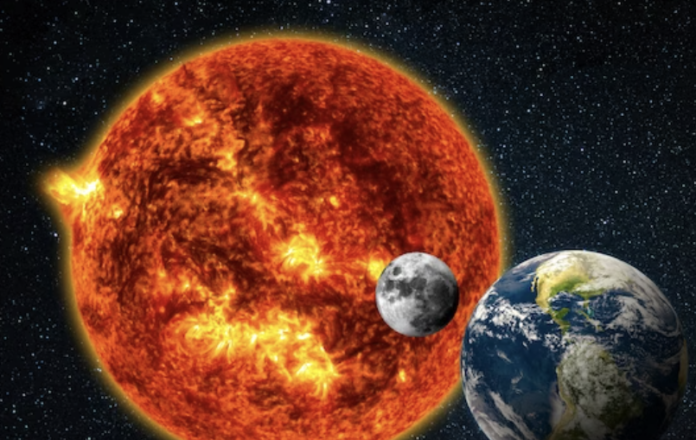Принаймні 5000 років земляни були вражені повними сонячними затемненнями. Але колись це явище може стати фольклором — ну, через 600 мільйонів років, плюс-мінус.
Приблизно кожні 18 місяців Місяць повністю блокує сонячне світло десь на Землі, створюючи повне сонячне затемнення. Одне навіть запланована на квітень у Сполучених Штатах , коли десятки мільйонів людей зможуть відчути це явище.
Насолоджуйтесь цим, поки можете, тому що Місяць віддаляється від Землі — приблизно на 3,8 сантиметра (1,5 дюйма) щороку, згідно з NASA. Коли середня відстань Місяця від Землі збільшиться ще на 14 600 миль, це буде занадто далеко, щоб повністю закрити Сонце з точки зору Землі.
«3,8 сантиметра на рік, можливо, ні для кого не означають багато», — сказав Ной Петро, учений з NASA. «Коли ви додаєте це протягом життя, протягом тисяч чи мільйонів років, це додається».
Повні сонячні затемнення – це небесне диво. Діаметр Сонця приблизно в 400 разів більший, ніж діаметр Місяця, але випадково воно знаходиться в 400 разів далі від Землі, ніж Місяць. Ці затемнення відбуваються, коли кутовий розмір Місяця (кількість простору, який він займає у вашому огляді) значною мірою збігається з кутовим розміром Сонця. У міру того, як Місяць просувається далі, його кутовий розмір буде здаватися меншим.
Якщо припустити, що Місяць продовжить віддалятися з нинішньою швидкістю — що є великим припущенням, сказав Петро, — Місяць пройде 14 600 миль (23 000 кілометрів) приблизно за 600 мільйонів років. Але враховуючи, що сонце, як очікується, росте в цей час, повні сонячні затемнення можуть зникнути трохи раніше.
Вчені виявили цей повільний дрейф, експериментуючи з відбиваючими панелями, зробленими з дзеркал, які залишилися на Місяці після місій Аполлон. Протягом десятиліть вони направляли промінь світла на рефлектори та визначали час, через який світло повертається на Землю. Вони виявили, що подорож лазера з кожним роком трохи подовжується, тобто Місяць просувається все далі в космос.
Обертання Землі, орбіта Місяця та обертання Місяця пов’язані між собою і утворюють кутовий момент системи Земля-Місяць, сказав фізик Річард Оленік. Кутовий момент залишається постійним для таких досить ізольованих систем, як Земля і Місяць; отже, якщо зміниться обертання Землі, то зміниться і орбіта Місяця. (Подумайте про те, як зберігається кутовий момент фігуристки, коли вона тягне руки і обертається швидше.)
Обертання Землі сповільнюється через сили тяжіння Місяця (хоча воно зменшується лише приблизно на 1,4 мілісекунди на століття). Це тому, що Місяць тягне земні припливи і відпливи, і океани планети випирають до нього. Ці приливні опуклості створюють опір і сповільнюють обертання Землі.
Щоб компенсувати уповільнення обертання Землі, орбіта Місяця стає більшою, сказав Оленік, професор Університету Далласа. Місяць також відкидає меншу тінь на Землю.
«Оскільки припливи і відпливи діють на Місяць дещо по-іншому, один із шляхів надходження енергії до Місяця полягає в тому, що він повільно віддаляється», — сказав Петро.
Ймовірно, Місяць дрейфував з самого початку свого існування. Вважається, що Місяць утворився з уламків після того, як великий об’єкт розміром з Марс зіткнувся з молодою Землею близько 4,5 мільярдів років тому. За словами Петро, моделювання передбачає, що Місяць міг бути на відстані 15 000 миль (24 000 кілометрів) після свого формування. З того моменту Місяць повільно віддалявся, хоча швидкість, ймовірно, коливалася протягом історії, коли Земля та її гравітаційне тяжіння змінювалися.
«Це відбувається так поступово. Це не було б так, як хтось одного разу прокидається і каже: «Ой, почекай хвилинку». Що тут сталося?», — сказав Петро.
Якщо через 600 мільйонів років на Землі все ще будуть людські покоління, вони побачать лише «вогняне кільце» або кільцеподібні затемнення, коли Місяць проходить повз Сонце, але не закриває його повністю. Місяць також може виглядати трохи меншим, ймовірно, як ми бачимо Місяць зараз у найвіддаленішій точці орбіти.
Коли Місяць віддаляється, «тривалість» земного дня також повільно змінюватиметься з часом, сказав Петро. Оленік сказав, що кутова швидкість Місяця також повинна сповільнитися, маючи на увазі, що Місяцю знадобиться більше часу, щоб пройти через свої фази. Припливи на Землі також будуть меншими, оскільки гравітаційне тяжіння Місяця буде слабшим.
І, можливо, об’єкти виглядатимуть трохи інакше, ніж Місяць.
«Я хотів би думати, що через 600 мільйонів років ми також матимемо людей на Місяці, озираючись на Землю», — сказав Петро. «І тому Земля стане дещо меншою».


